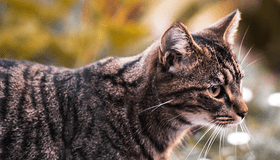October 20, 2016 – A sudden cry and collapse can signal one of the most dreaded diseases in cats –arterial thromboembolism. In ATE, abnormal blood clots form in the blood stream and then lodge in blood vessels, cutting off blood supply and causing sudden pain and collapse. The disease is notoriously difficult to treat and often strikes cats without warning. Therapy can be expensive, and mortality rates are high even with timely intervention. Cats that recover from an episode require long-term therapy and recurrence is common. New treatments are desperately needed that are both practical and effective.
Two recent publications from Morris Animal Foundation-funded studies provide new insights into the treatment of this deadly disease. The first publication is from a research team at the University of California, Davis. Dr. Ron Li and colleagues looked at how genetics influence the way cats respond to clopidogrel (Plavix®). They knew that people can have widely different responses to blood thinners, and they wanted to determine if the same situation to cats.
“We found that cats with the genetic mutation that predisposes them to heart disease had platelets that were more reactive than platelets from cats without the genetic mutation,” said Dr. Li. “Although clopidogrel is a commonly prescribed anti-platelet drug, its effect on platelet function was highly variable among cats in our study. This study suggests that not only do platelets play a key role in clot formation in HCM cats but that not all cats respond to clopidogrel the same way.” Dr. Li hopes this finding will not only help clinicians understand why some cats fail therapy, but might lead to more studies to learn how to better use this medication in cats with heart disease.
A second study from researchers at the University of Georgia tested a commonly used human blood thinner, rivaroxaban, in cats. Rivaroxaban is used in people to treat deep vein thrombosis and prevent strokes. The team in Georgia speculated that this drug might work in cats to prevent ATE. They studied how the drug was metabolized in cats, and whether it had blood thinning activity. They found that cats tolerated the drug with no adverse side effects, and the drug showed good anti-clotting activity. Based on these promising results, the research group is now actively recruiting cats with heart disease who survived one episode of ATE into a study that will determine if treatment with rivaroxaban will prevent further clot formation.
The good news is that as more treatment options are available for cats, prognosis is slowly improving. We still have a long way to go, but the development of new drugs to treat and prevent ATE gives hope that our feline friends will live healthier, longer lives.
Listen to our Fresh Scoop podcast to learn more about cats, heart disease and blood clots.




